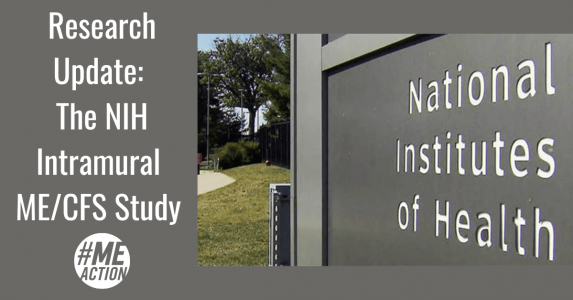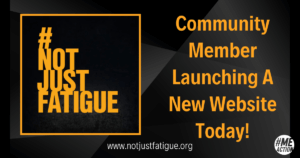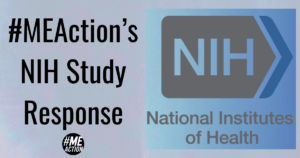National Institutes of Health researchers who began what may be the deepest biological investigation ever of myalgic encephalomyelitis/chronic fatigue syndrome (ME/CFS) are writing up their findings and plan to circulate a draft among their large team of scientists and physicians for feedback soon.
“The study will help patients and should move the field forward in a big way,” said NIH neurovirologist Avindra Nath, the principal investigator of the study that brought ME/CFS patients into the agency’s large Clinical Center in Bethesda, Md. “The huge benefit is to move toward clinical trials” of drugs, he added.
Nath said the study has identified consistent biological problems in ME/CFS patients, who spent up to four weeks as NIH inpatients over two visits. “It was important to convince ourselves that there really are biological problems that are reproducible and consistent, and to develop expertise to study ME/CFS, because we hadn’t looked at it before. Then we will move on to treatment studies. We have a number of different candidates [drugs] we would like to try.”
The study was launched in late 2016 after then-NIH director, Francis Collins, responded to patient pressure to invest in helping patients with a long-neglected and often-devastating chronic illness. While the study protocol was approved quickly, completing the study has lagged.
Representatives from #MEAction repeatedly pushed NIH to speed up the study before COVID. In a public letter and personal conversations with Nath and Walter Koroshetz, director of the NIH’s National Institute of Neurological Disorders and Stroke, #MEAction asked the NIH team to bring in two patients simultaneously and otherwise find ways to increase their pace.
The research involved extensive substudies of immunology, physiology, metabolism, autonomic function, and more. Patients gave detailed histories of their illness, donated blood, spinal fluid, skin and muscle tissue, underwent magnetic resonance imaging scans, cognitive testing, sleep studies, cardio-pulmonary exercise tests, and spent several days in a metabolic chamber. More than thirty researchers from across NIH participated.
Nath admitted that it has taken him too long to complete and write up the research. “COVID has pretty much taken over my life,” he said. In March 2020, the Clinical Center closed to most patients, ending enrollment a few patients short of the initial goal. Nath then began autopsy studies of people who died of COVID-19 and eventually began studying people with Long COVID, or as the NIH terms it, post-acute sequelae of COVID. Nath has said that many cases of Long COVID strongly resemble ME/CFS.
With patient investigations ended at the start of the pandemic, Nath assembled five working groups to analyze the ME/CFS study’s huge data sets. “We had an immunology group, a physiology group, and so on,” he said. “The analyses are very cumbersome and take a long time. It’s all slower than anyone wants, including myself.”
Last fall, Nath and the study’s lead clinical investigator, Brian Walitt, began meeting every weekend to synthesize the findings and to write up the results. Nath, who has an extensive track record of publishing research in top journals, and whose research is cited more than 45,000 times in the medical literature, said, “I’ve never written a paper of this huge magnitude in my life. I feel badly that it’s taken so long. But we have so much to synthesize, Brian and I. Today we were working on the discussion section,” which usually appears at the end of a research report and tries to put the results in a larger context.
Nath acknowledged that patients want to see results, but when asked if he would consider posting the draft paper as a preprint – a method of sharing research before formal peer review – he balked. He said top medical journals tend to reject papers that have gotten attention as preprints, and he also favors letting peer review run its course before sharing findings.
Nath also said that the NIH intramural research program – its scientists who work in Bethesda – has now developed expertise in studying and understanding ME/CFS and related conditions. The Veterans Administration has asked his team for help in studying veterans with Gulf War Syndrome using a similar in-depth protocol, and the intramural group is also continuing to study Long COVID patients who they say will meet ME/CFS criteria. We are reaching out to NIH to learn how they will be diagnosing ME/CFS in study participants and whether they will use the same strict protocol used for diagnosis in the ME/CFS intramural study.







12 thoughts on “Research Update: The NIH Intramural ME/CFS Study”
This is such an important study. Thank you, #MEAction, for continuing to push NIH. We need answers and a way forward!
Wow. So glad to hear about this. Good job advocating for getting patients in there more quickly 🙂 Thanks for the update 🙂
Thanks Cort!
Thank you very much for this important Studie 💙❤️
Sounds really exciting. Thank you.
Six years into this study, and all they have come up with is… Gee they appear to be sick.
Thank you! I finally feel a glimmer of hope.
It will be interesting to see the publications. ME and FM are both auto-immune disorders with possible underlying various viral pathology. This is what we are seeing with “long covid”. With these syndromes the symptoms and underlying pathology are variable and variant. Much research has been driven by the symptoms and attempts at treatment have been driven by those symptoms. It is only when we understand the underlying immune disorder and how it leads to the symptoms, we will have effective treatment.
Waiting waiting as we all have for decades. Hoping hoping as we all have for decades.
Sincerely, hipjaven
I’m a veteran and would love to work with the VA if they need patients. I’m hopeful for this news.
hi beth et al., thank you for the update and especially for your efforts. with attention on nih, perhaps they will interfere less with the paper.
i like the greater emphasis in general these days on disease communities cooperating.
i was displeased with aspects of the study esp early and nih attitude but the resource is one that pwme need and deserve. for newcomers, we’ve seen hope come and go, but this is a hopeful announcement if they pull through. i hope small n is enough.
one thing: pwme need access to drugs. suppose the paper reports some possibilities that are safe enough for certain pwme to try soon given their risk/reward [while most pwme might be VERY VERY strongly advised to wait for good science just as with rituximab which didn’t turn out as hoped]. the theoretical existence of a drug that works is no good for them if they do not have access to it. thus i hope that off-label and on-label access for pwme can be an activism priority starting now. this might sound crazy, but free access should be explicitly on the table.
the pidd community got together and basically got that with a law and home access so that they do not have to go to hospital and get infected or not have access becasue bedridden and housebound. it might also be similar to early hiv/aids where they were also able to create law. the research and services and availability of medicine in some places like usa for hiv/aids might seem extraordinary when viewed from a pwme perspective who have never had much of any positive treatment ever, but is not considered so by some pwhiv.
old article but there are likely better new ones describing hiv/aids medicine access: http://www.nytimes.com/1997/11/12/us/new-challenge-to-idea-that-aids-is-special.html . recent article showing medicine access problems in the usa: https://www.hrw.org/report/2022/04/12/if-im-out-insulin-im-going-die/united-states-lack-regulation-fuels-crisis .
that last one was written by human rights watch. some hr ngos [there are many] might help play a role in principle. the right to health law explicitly talks about this stuff in factsheet 31. the disability treaty and ohchr in general [incl sr/mh] might be invoked in principle.
good to avoid a learned helplessness or we don’t deserve anything type of attitude because of our history.
keep in mind that this can reach bad extremes. i have angioedema and at one point one drug was 150,000 usd per DOSE. another 140,000 per year. and so on. we do not know what drugs nath refers to, so it might be best to start activism early. remember ampligen / epi-pen.
there is a caveat that we don’t want charities too cozy with pharma [e.g. one pidd community charity advertises medicines in their newsletters possibly contributing to locking in a single treatment for those diseases by incentives] or for science or pharma in general to forsake those who cannot tolerate a drug or for whom it does not work or is contraindicated.
is #meaction looking into any of this stuff?
again thank you.
as an ME sufferer over many years now 69 . having been treated by all doctors differently to scathing remarks like i dont believe in ME and do you not want to work ? to beng told by a trainee doctor that she found my notes facinating and id i think ive every got over ME ? . mine i can track back to a live polio vaccine but dp has not a clue about anyting about that . . . so present day sufferers of long covid dont stand a chance . unless some massive breakthrough comes . i hold my breath on that . . like the rest of us they will just be left to get on with it and as time goes by become forgotten about and have to fight for anything to help via social security and care . . . i laugh as on my computer file at gp flags up the the words neurotic . . great . they really understand . NOT . . i rest my case . i rarely go to gp . and i wonder if being bit in the back by a horse and smashing my c5 disc in half and a broken facit joint on my spine is neurotic as was being poisoned by a live polio vaccine popped in my mouth by a well meaning nurse when admistering my sons vaccines at 2 . .blah blah . i dont have the energy to be neurotic and feel totally insulted by this . .
Comments are closed.